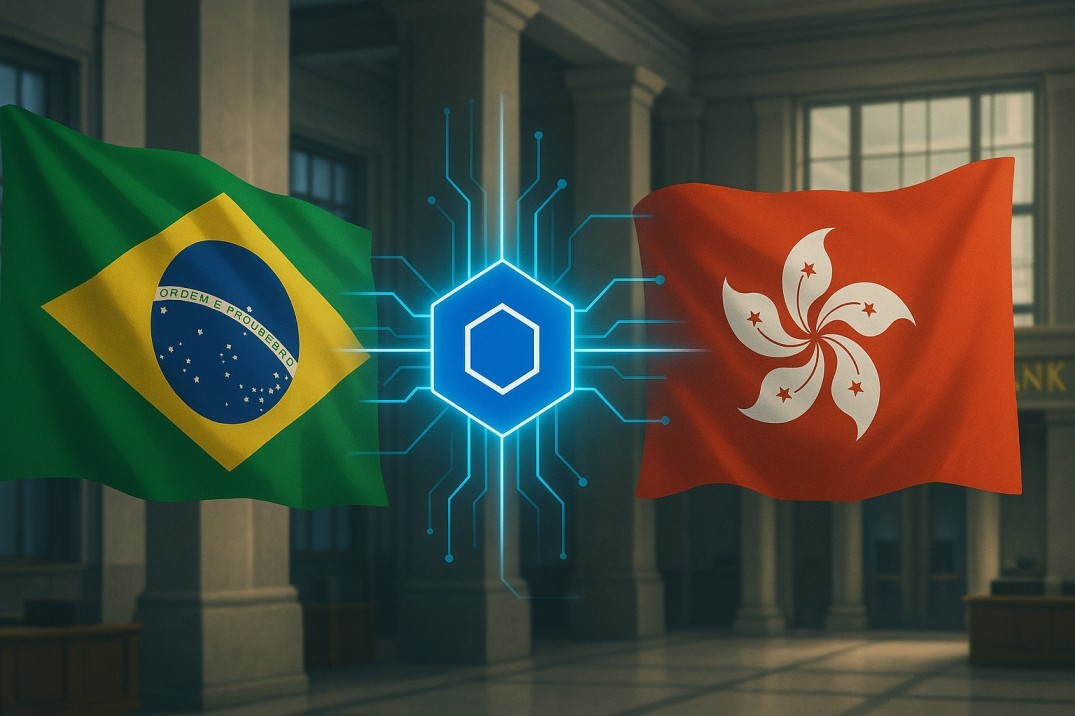TL;DR
- Banco Inter, in collaboration with Chainlink, the Central Bank of Brazil (BCB), and the Hong Kong Monetary Authority (HKMA), completed a pilot for cross-border trade finance using blockchain.
- The project connected Brazil's Drex network with Hong Kong's Ensemble platform, marking a major milestone in blockchain interoperability.
- The experiment demonstrated how distributed ledger technology (DLT) can automate complex trade finance settlements.
- Standard Chartered also participated, signaling growing institutional confidence in blockchain-based financial infrastructure.
- The test reflects Brazil's growing leadership in CBDC innovation and global movement toward programmable, interoperable finance.
Cross-border trade finance is notoriously slow, involving mountains of paperwork, multiple intermediaries, and delayed settlements. But what if these processes could be executed instantly-with full transparency and security-across borders? That's the question Banco Inter, one of Brazil's most forward-looking digital banks, set out to explore. In collaboration with Chainlink, the Central Bank of Brazil, and the Hong Kong Monetary Authority (HKMA), Banco Inter completed a pilot that may reshape how trade finance operates globally.
The pilot, conducted under Phase 2 of Brazil's Drex CBDC initiative, simulated a real-world export transaction between two distinct blockchain networks-Brazil's Drex and Hong Kong's Ensemble-with Chainlink providing the interoperability layer to link them securely.
How the Experiment Worked

At the heart of the test was DvP/PvP-industry shorthand for Delivery versus Payment and Payment versus Payment. These are the foundational mechanisms ensuring that goods and payments move simultaneously, eliminating settlement risk.
Through Chainlink's Cross-Chain Interoperability Protocol (CCIP), the Drex and Ensemble platforms communicated seamlessly, exchanging transaction data, settlement confirmations, and asset transfer proofs. The process simulated a full trade cycle: a Brazilian exporter shipping goods to a Hong Kong buyer, with the payment automatically triggered upon delivery confirmation. All actions were verified through smart contracts, ensuring both sides fulfilled their obligations before funds were released.
By executing this on blockchain, the system demonstrated how DLT could replace the slow, trust-based systems that dominate global trade finance today.
Why This Matters
Trade finance has long been one of the most stubbornly complex areas of banking. Every transaction involves multiple parties-exporters, importers, banks, insurers, customs authorities-all relying on different systems.
This experiment showed how blockchain interoperability can synchronize the movement of goods, payments, and title transfers in a single, verifiable framework. For developing economies, this is more than a technical upgrade-it's an opportunity to expand credit access and modernize financial systems without overhauling existing banking infrastructure.
Brazil's Drex Project: More Than a Digital Real
Brazil's Central Bank has been quietly accelerating its digital currency efforts through Drex, often labeled as a CBDC-but officials say it's much broader. Gabriel Galípolo, President of the Central Bank of Brazil, described Drex not as a simple central bank digital currency but as a digital infrastructure project aimed at expanding credit access, improving transparency, and modernizing the nation's financial backbone.
Drex's design focuses on programmability and privacy, allowing smart contracts to automate complex financial workflows while ensuring compliance and oversight remain intact. And the timing couldn't be better. According to Galípolo, around 90% of crypto transactions in Brazil now involve stablecoins, highlighting the country's readiness for a programmable, blockchain-powered economy.
Hong Kong's Ensemble and the Asian Connection
On the other side of the experiment sits Hong Kong's Ensemble, a blockchain platform developed under the HKMA's Project Ensemble initiative. Hong Kong has positioned itself as a regional hub for tokenized finance, experimenting with blockchain-based settlement systems that connect banks, corporates, and payment service providers.
The Ensemble platform plays a key role in this vision, allowing cross-border transactions to occur with programmable logic, ensuring instant settlement while maintaining strict regulatory compliance. The integration of Drex and Ensemble through Chainlink creates a bridge between Latin America and Asia, potentially setting the stage for a new era of trade efficiency between emerging markets.
The Role of Chainlink
Chainlink, known for powering decentralized data connections, has become the go-to infrastructure for cross-chain communication. By acting as a secure middleware, it enables institutions to connect private and public blockchains without compromising on data security or regulatory requirements.
In this pilot, Chainlink's CCIP provided the backbone for cross-network interoperability, ensuring that messages and transactions between the Central Bank of Brazil and the HKMA were cryptographically verified and tamper-proof. This success marks a major step forward not just for Chainlink, but for the broader blockchain industry seeking institutional-grade use cases.
Institutional Confidence Rising
One of the key highlights of this pilot was the involvement of Standard Chartered, a major global bank with a strong presence in both Asia and Latin America. Its participation signals growing institutional confidence in blockchain's potential to streamline financial processes beyond retail or crypto-native applications.
For global banks, blockchain interoperability offers the ability to cut costs, reduce settlement delays, and improve liquidity management-all while maintaining regulatory transparency.
Final Thoughts
This pilot might not immediately change how trade is conducted, but it lays the foundation for a new era of financial connectivity-one that removes friction from cross-border transactions and brings global institutions onto the same digital rails.
What began as an experiment between two regions could soon inspire others-from Europe to Africa-to explore similar models. In that sense, the Brazil-Hong Kong pilot isn't just about interoperability. It's about redesigning the trust architecture of global trade.











